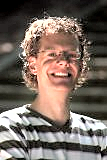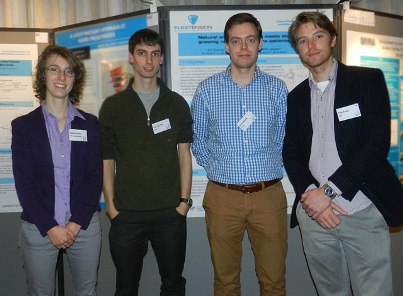Dutch Scientists Develop A-gear Novel Wearable Dynamic Arm For Duchenne Muscular Dystrophy Patients
by |

A team of research scientists based at the University of Twente Department Of Biomechanical Engineering in Enschede, The Netherlands, is developing a passive arm support device prototype, dubbed A-gear, that runs along the body from the contact surface between the seat and upper legs via the torso and upper arm to the forearm and is designed to be worn inconspicuously under clothing. As opposed to existing arm orthotics devices, the A-gear’s proposed kinematic structure allows trunk motion and requires fewer links and less joint space without compromising balancing precision of movement.
Twente’s Biomechanical Engineering group (BME) specializes in the application area of Biomedical Technology, with their research nexus at the interface of technological and medical sciences — focused on interaction between the human motor system and medical devices that support this system. The goal is to better understand (impaired) human movement control, and to develop new methods and technologies for diagnosis, recovery, and support of subjects with movement disorders. The result of this research is applied practically in development of innovative devices like A-gear. aimed at improving the quality of life of patients with sensory or motor disorders, resulting in their increased independence;
Duchenne muscular dystrophy (DMD) is a hereditary neuro-muscular disorder mainly affecting boys (DMD is very rare in girls) caused by mutations of the dystrophin gene located on the X chromosome. This genetic anomaly leads to absence of (or a defect in) the dystrophin protein, which normally suports connection of muscle fibres to the extracellular matrix. DMD affects approximately 1 in every 3500 live male births and it is characterized by progressive muscle degeneration. Most patients are diagnosed at an age of approximately 5 years, when their physical ability diverges markedly from that of their peers.
As they grow older, their muscles become weaker because the body is unable to produce a muscle protein called dystrophin resulting in the muscle cells weakening and gradually breaking down. Signs of weakness usually first manifest when the boys are between three and five years of age (sometimes earlier) mostly in the legs and hips, with affected children falling frequently, having trouble running as fast as their peers, climbing stairs, or getting up from chairs and are often unable to run and jump due to proximal muscle weakness. Physiologically they tend to develop big calves, frequently walk on their toes and lean backwards to keep their balance. Eventually muscle strength deteriorates and weakness associated with DMD makes walking more difficult, with use of a wheelchair needed before affected boys reach their teens. Gradually, all the muscles become very weak, including the muscles used for breathing and the heart.
DMD has a predictable nature of complications. Muscles in the legs are first affected, leading to loss of independent ambulation by the age of 13, followed by muscles of the upper extremities. There is a strong decrease of arm function between the age of 10 and 16, although function of the hand remains relatively good. Eventually the heart and respiratory muscles will fail.
Until several years ago, DMD resulted in life threatening situations around the age of 20. Corticosteroid, respiratory, cardiac, orthopaedic, and rehabilitative interventions have not only led to improvements in function, quality of life and health, but also an extended live expectancy. In the case of boys with DMD, due to improved medical care and technical possibilities, life expectancy has increased rapidly, and children who are diagnosed today have a life expectancy into the fourth decade. As a consequence, most of them will have no functional arm movements for more than half of their life, if unsupported. On account of the increased lifespan, maintaining a proper arm and hand function is very important to increase independence.
RELATED: New Potential Lupus Drug Targets B Cell Receptor
The Flextension Foundation project, a collaboration of hospitals, universities, rehabilitation centres, rehabilitation doctors, companies and engineers with a common interest in Medical Technology was founded in 2007 in response to demand from the Duchenne community to find technological solutions to improve their quality of life for boys and young men with DMD. The Foundation’s board consists of volunteers working in different universities and volunteers active in the Duchenne community. The purpose of the Flextension Foundation is developing new tools that improve the quality of life of boys and young men with Duchenne. In the past seven years, the Flextension Foundation has initiated numerous research projects with more than 40 partners in several countries.
Flextension’s partners are confident that with the technology available nowadays it will be possible to develop better, innovative aids for Duchenne patients, and moreover that by solving movement problems in DMD patients, those problems can also be solved for many other diseases. To realize this, they conduct research, develop assistive devices, connect different parties from the work field in a network, support the marketing of the products developed and to communicate the progress and success to support future development.
 Flexation research team leader Ir. Arjen Bergsma studied Biomedical Engineering at the University of Twente, and in 2009 obtained his master degree based on the assignment: “Design of a wearable arm support with
Flexation research team leader Ir. Arjen Bergsma studied Biomedical Engineering at the University of Twente, and in 2009 obtained his master degree based on the assignment: “Design of a wearable arm support with passive gravity compensation.” After his master Ir. Bergsma started as a researcher within the Twente faculty of Engineering Technology under the supervision of Prof.Dr.Ir. Bart Koopman to coordinate the Flextension project and to work on the redesign of a wearable arm supporting device.
passive gravity compensation.” After his master Ir. Bergsma started as a researcher within the Twente faculty of Engineering Technology under the supervision of Prof.Dr.Ir. Bart Koopman to coordinate the Flextension project and to work on the redesign of a wearable arm supporting device.
The researchers knew from user surveys with existing arm orthotics devices that they should integrate well with social aspects of activities, such as eating, with preference for a body-bound orthotic system rather than an external robotic assistive device. Arm supports or robotic arms can be mounted to wheelchairs to aid in arm motion, but they are quite visible and therefore limited in their possibilities due to their fixation to the wheelchair. The stigmatizing effect of assistive devices was indicated as an important reason for not using them. Users prefer inconspicuous arm supports that are comfortable to wear and easy to control.
One survey, in which 350 persons with DMD participated worldwide, determined that only a small percentage (8.5 %) of DMD patients use an arm support. In addition, this survey describes which activities of daily life (ADL) tasks are most important for DMD patients. Essential activities performed with an arm support include eating, drinking, use of a phone and computers, personal hygiene, physical contact with others and dressing. Persons with DMD will use an arm support while seated only, since they are in a wheelchair at times they need such a device. Patient Wishes with respect to the arm support, apart from increased ability, include inconspicuousness, intuitive control, easy donning and comfort, and the arm support would preferably be worn underneath clothing, e.g. sweater and pants.
The prototype design for an inconspicuous arm support for ADL tasks is called A-gear, with the A standing for ability. Ergo, the A-gear is a piece of equipment for increasing the user’s ability.
Also noted is that from a clinical point of view it is important to continue using the patient’s own muscles as much as possible to move the arms, since disuse will invoke formation of contractures. With those points in mind, the project’s objective was to perform research resulting in development of an orthotic device that can provide adaptive support during various stages of DMD.
To achieve the stated objective, it was necessary for the investigators further comprehend the following principles:
1) How can a DMD patient’s arm function be supported with a minimal construction that will be least stigmatizing and that stimulates use of remaining muscle functionality maximally? The support may contain both passive as active components, which will result in design of an active arm orthosis that provides adaptive support.
2) How can this device be controlled intuitively in a safe way? The control may be adaptive in that it learns which movements are performed on a regular basis and may require gradually increased support. This will result in design of an intuitive control interface for the orthosis. Innovative aspects include potential to explore intention detection and use of learning elements for the control system.
3) How can the functional needs and capacities of any individual DMD patient in each stage of the disease be quantified, and what is the clinical performance of the newly developed supports? Innovative aspects are identification of the effect of the new orthosis during the various stages of DMD.
A lot of research has been done over more than 1.5 years,and development of a first passive Flextension A-Gear prototype (without electromotors)is finished. This prototype has been extensively tested in healthy subjects as well as in boys with Duchenne. The researchers report that first results have been positive with increased range of motion for boys with Duchenne, and indication of less fatigue when using the A-gear arm support. However some points needing improvement have also been noted,,and work is underway on designing and assembling a second prototype, which will be tested extensively as well.
The research background of the Flextension A-gear project is described in an Open Access research paper published in the Journal of NeuroEngineering and Rehabilitation, entitled “Design and pilot validation of A-gear: a novel wearable dynamic arm support” (Journal of NeuroEngineering and Rehabilitation 2015, 12:83 doi:10.1186/s12984-015-0072-), co-authored by Peter N. Kooren and Micha I. Paalman of the VU Medical Center Department of Physics and Medical Technology in Amsterdam, The Netherlands; Alje G. Dunning and Just L. Herder of the Delft University of Technology Departments of Precision & Microsystems Engineering and Biomechanical Engineering, at Delft, The Netherlands; Mariska M.H.P. Janssen and Imelda J. M. de Groot of the Radboud University Medical Center Department of Rehabilitation, Donders Center for Neuroscience at Nijmegen, The Netherlands; and Joan Lobo-Prat and Bart F. J. M. Koopman of the University of Twente Department of Biomechanical Engineering at Enschede, The Netherlands. Just L. Herder is also associated with the University of Twente Department of Mechanical Automation.
 Photo caption: The Flextension A-Gear Research group’s Mariska Jansen, Joan Lobo, Gerard Dunning, and Peter Kooren
Photo caption: The Flextension A-Gear Research group’s Mariska Jansen, Joan Lobo, Gerard Dunning, and Peter Kooren
Corresponding author Peter Kooren studied Mechanical Engineering at the University of Technology in Delft. After completing a graduation project at Philips Healthcare in 2008, for three years he worked for a R&D company focusing on steerable instruments for minimal invasive surgery. Currently a design engineer in the department of Physics and Medical Technology at VU medical center in Amsterdam, he is responsible for integrating the different parts of the He is responsible for integrating and coordinating the different parts of the Flextension project design group.
In the paper, the design, characterization, and pilot validation of a passive arm support prototype, which is worn on the body, is presented. The A-gear is mounted with the user sitting on five pads (two below each upper leg, one against the users bottom). The pads are flexible and can be formed to the body. The pads are clicked onto metal tubes, which fixates their shape. The forearm link is attached to the user’s arm with a pad and a Velcro band. The upper arm pad is only to prevent the forearm from slipping from its pad when pointing upward. The pad against the forearm is the dominant contact point.
Since the user is sitting in the device mechanism and it is only attached to the upper and lower arm, the complete apparatus is easy to put on and take off. Moreover, since the structure runs parallel to the users arm and trunk, it can to be worn underneath clothing. Freedom of motion is accomplished by mechanical joints, which are nearly aligned with the human joints. The system compensates for the arm weight, using elastic bands for static balance, in every position of the arm. Unlike existing arm orthotics devices, the proposed kinematic structure allows trunk motion and requires fewer links and less joint space without compromising balancing precision.
The researchers say measurements made using functional prototype on three DMD patients employing 3D motion analysis showed increased arm performance with the subjects wearing the prototype. In a questionnaire regarding device functionality, comfort, aesthetics, safety, compatibility and donning and doffing, participant subjects noted finding upward and forward movements easier while downward movements were deemed more difficult. On average, participants felt a little limited in their range of movement by the prototype, however all stated that they were all still able to perform important activities, such as drinking and reaching for objects. In addition, the participants stated that the prototype fitted well and felt comfortable. However, sometimes the shoulder parts of the prototype interfere with the shoulder of the user or the wheelchair and sometimes the arm part collided with the table or wheelchair. The lower arm interface felt comfortable to all participants. All participants stated that the arm support could not be worn underneath clothing. The opinions about the looks of the prototype differed between participants. One participant stated that he thought the visible parts of the prototype looked nice, while other participants stated that the appearance of the prototype should still be improved before they were willing to wear it in daily life.
On the level of safety all patients were satisfied. The arm was steadily attached in the arm support. Furthermore, the prototype did not make unintended movements and was stable. One participant felt his skin getting pinched near the shoulder, while other participants did not have this experience. The prototype did not inhibit breathing. Donning the prototype was experienced harder than doffing the prototype, although most participants thought that the time it took to put on and off the prototype was reasonable.
Overall, all patients stated that they would like to use such an arm support in daily life, however they would also like to see some adaptations to prevent collisions with the body and surroundings and on the looks of the prototype.
The study coauthors conclude that the A-gear prototype is a step towards inconspicuousness in dynamic arm supports and therefore well-received by people with muscular weakness. The A-gear prototype is therefore a step towards well adopted dynamics arm supports that improve participation in society, and make people with muscular weakness more independent and more able to perform important activities in daily life.
Sources:
Flextension Adaptive Arm Orthotics For Children With Duchenne Muscular Dystrophy project
The University Of Twente
Journal of NeuroEngineering and Rehabilitation







